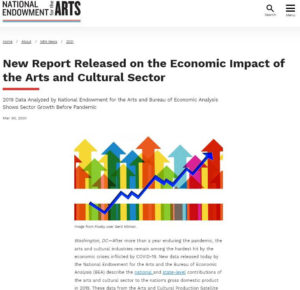
The numbers are out: arts and cultural industries contribute nearly a trillion dollars to U.S. GDP, you read. They employ 5.2 million workers (not counting the self-employed), and continue to keep admirable pace with our growing economy. Then you spot the dateline. Released on March 30 by the Bureau of Economic Analysis and the National Endowment for the Arts, the findings cover 1998-2019, stopping tantalizingly short of the first year of the COVID-19 pandemic.

Still, if we are to believe analyst projections, at least two trends here are likely to continue. Compared with the average annual growth rate of arts and cultural industries as a whole (+3 percent), web streaming and web publishing surged by 12 percent, in terms of the value added by those industries to the U.S. economy. The book and software publishing industry grew by over 7 percent. In both cases, we might expect to see sustained if not accelerated growth when the 2020 numbers are released next year.
As early as May 2020, a J.P. Morgan Research report cited growing consumption of at-home entertainment across multiple platforms. More recently, a review of personal consumer spending data shows that Americans shelled out $40 billion for “video and audio streaming and rental services” in the fourth quarter of 2020, up from $36 billion in the first quarter. (The estimates are seasonally adjusted.) Indeed, consumer spending in this category has more than doubled since Q1 2015, when it was just shy of $17 billion.
So much for demand—what of supply? In a sentence that could have been written for museums and performing arts groups, the analysts state: “When…new streaming services come to market, they may need to rely more on library programming [i.e., archival content] initially since COVID-19 has halted the production of original content.” But here those web streaming companies are at an obvious advantage to most presenters of online art exhibits or performances. Apart from their greater capacity and competency in producing and distributing shows or films expressly for video, such firms can rely on legacy content to satisfy a good share of that consumer demand.
Also from a supply perspective, it is telling that even in Q4 2020, the unemployment figures were far lower for producers and directors (4.6 percent) and for TV, film, and video camera operators (though still distressingly high at 9.7 percent) than for many other artist occupations. In that quarter, 77.8 percent of dancers and choreographers were unemployed, as were 47.6 percent of actors and 21.5 percent of musicians. (These figures are national and do not account for regional variance.)

For books and publishing, prospects are similarly bullish. In January, three industry analysts issued the report COVID-19 and Book Publishing: Impacts and Insights for 2021, in which they wrote: “Amid the upheaval, book publishers have, on the whole, fared well. The publishing industry, straddling as it does the poles of analog/digital, large/small, and for-profit/not-for-profit, has largely escaped the COVID-inflicted disruptions faced by several other sectors.”
Again, consumer spending data are instructive. From Q1 to Q4, spending on books (print and electronic) grew by nearly 13 percent, to more than $25 billion, according to seasonally-adjusted estimates from the BEA. This compares with a 5.5 percent growth rate in book spending from Q1 to Q4 in the preceding year. There are also positive signs on the supply front: The NPD Group (owners of Nielsen BookScan) has reported increases in print book sales in 2020, up 8.2 percent from 2019.
For web streaming and book publishing alike, the favorable numbers mask the existential struggles endured by so many small and/or nonprofit arts organizations in these industries today. (Just think of indie bookstores and small presses.) The data also cannot give reassurance, much less guidance, to those seeking to understand how minority-owned arts businesses have fared in the past year. Still, the anticipated growth for both industry groups is testimony to the staying power of at-home entertainment options in the arts and cultural sector more broadly—even when in-person arts attendance is again capable of competing for our leisure time.

Do you mind if I quote a few of your posts as long as I provide credit and sources back to your website? My blog site is in the exact same niche as yours and my visitors would genuinely benefit from a lot of the information you provide here. Please let me know if this okay with you. Appreciate it!
Go for it. Thanks!